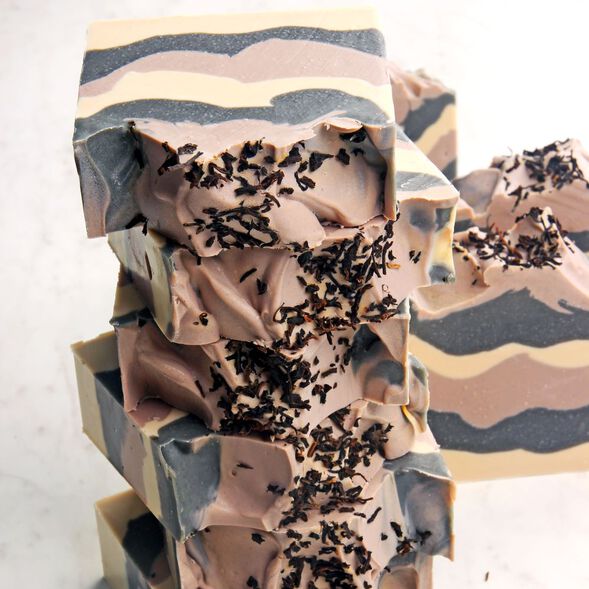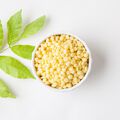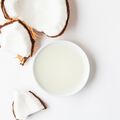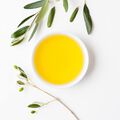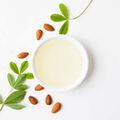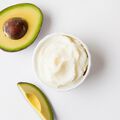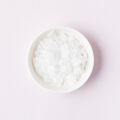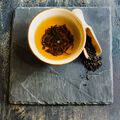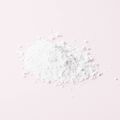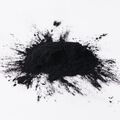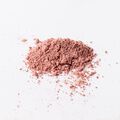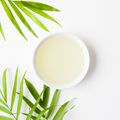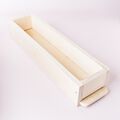
Black Tea Cold Process Soap Project
- Skill Level: Intermediate
- Time: 2 hours
- Yield: 5 Pounds of Soap
Project Description
This project is scented with Bergamot Black Tea Fragrance Oil, which is a complex blend of smoky tea leaves, bright bergamot, and a subtle base of amber. It’s a fantastic unisex fragrance oil.
If you’ve never replaced water in your recipe with tea, it’s easier than you think. Simply brew the tea, allow it to cool, and mix in the lye like you would with water. The lye solution will become a dark brown, so this recipe contains titanium dioxide to lighten the color. Rose Clay adds a natural pink hue, while activated charcoal gives a deep gray color.
Because this recipe does contain plenty of titanium dioxide, it has a 20% water discount. The first time we made the soap without one, we got a lot of glycerin rivers (learn more about them here). The water discount - or in this case, tea discount - eliminated them completely. The discount also helps to achieve a thick, easy-to-layer texture.
You will need:
- 5 lb. Wood Mold with Sliding Bottom
- Silicone Liner for 5 lb. Wood Mold
- 2.7 oz. Cocoa Butter (5%)
- 13.5 oz. Coconut Oil (25%)
- 2.7 oz. Avocado Butter (5%)
- 16.2 oz. Olive Oil (30%)
- 13.5 oz. Palm Oil (25%)
- 5.4 oz. Sweet Almond Oil (10%)
- 14.3 oz. Brewed Black Tea (20% water discount)
- 7.6 oz. Sodium Hydroxide Lye
- 2 oz. Bergamot Black Tea Fragrance Oil
- Titanium Dioxide
- Activated Charcoal
- Rose Clay
- Black Tea Leaves (for the top & to brew tea)
- Large Sealable Tea Bag (for brewing tea)
COLOR PREP: Disperse 3 teaspoons of titanium dioxide into 3 tablespoons of sunflower or sweet almond oil (or any other liquid oil). Disperse 1 teaspoon of activated charcoal into 1 tablespoon of liquid oil. Use a mini mixer to work out any clumps. Then, disperse 3 teaspoons of rose clay into 3 tablespoons of distilled water. Because clays absorb moisture, we recommend dispersing them in water rather than oil. Use a mini mixer or small spoon to disperse the clay. OPTIONAL: To ensure that the titanium dioxide blends smoothly into the soap, we recommend micronizing it before dispersing it in oil. To micronize the colorant, simply use a coffee grinder to blend it. That breaks up any clumps of color and prevents streaks of white from showing in the final soap. We like to use a coffee grinder that has a removable stainless steel mixing area for easy cleaning.
*Note: This project was originally created with the now discontinued Purple Brazilian Clay. Rose Clay will yield a pinker shade than shown in the photos.
FRAGRANCE OIL PREP: Measure 2 ounces of Bergamot Black Tea Fragrance Oil into a glass container. Set aside.
BLACK TEA PREP: Boil 16 ounces of distilled water to prepare the tea. It’s best to prep more tea than you need, because you will lose some during the steeping process. Add 4 tablespoons of black tea into a tea bag. Iron the tea bag closed, and place in the hot distilled water. Allow it to steep and cool for about 1 hour. Remove the bag and wait for the tea to cool to about 70° F. Cooler tea will discolor less when the lye is added. If you’d like, you can also freeze the tea into cubes before adding the lye.
Measure out 14.3 ounces of tea. If you don’t have enough, add more distilled water. Save the tea leaves to place on top of the soap if you’d like. Place them on a paper towel to dry until you’re ready to use.
SAFETY FIRST: Suit up for safe handling practices. That means goggles, gloves, and long sleeves. Make sure kids, pets, other distractions, and tripping hazards are out of the house or don’t have access to your soaping space. Always soap in a well-ventilated area.
Follow these steps:
1
Slowly and carefully add 7.6 ounces of lye to 14.3 ounces of black tea and gently stir until the lye has fully dissolved. It will turn a dark brown color. Set aside to cool and then add 3.5 teaspoons of sodium lactate.
2
In a large heat-safe container, fully melt and measure 13.5 ounces of coconut oil, 16.2 ounces of olive oil, 2.7 ounces of cocoa butter, 2.7 ounces of avocado butter, 5.4 ounces of sweet almond oil, and 13.5 ounces of palm oil. Once the lye water and the oils have cooled to 130° or below (and are ideally within 10 degrees of each other), add the lye to the oils and stick blend until you have a thin trace.
3
Once you reach a very thin trace, add all the Bergamot Black Tea Fragrance Oil.
4
Split off about 26 ounces of soap into a separate container. Add 2 teaspoons of dispersed activated charcoal and use a whisk to fully mix in. Set aside.
5
Add all the dispersed titanium dioxide into the large amount of remaining soap and use the stick blender to fully incorporate. Split the batch in half. Each should weigh about 26 ounces. Add all the dispersed rose clay to one container and use the stick blender to incorporate. Leave the other container of soap uncolored.
6
Now it’s time to start layering! First, make sure all the colors of soap are a medium to thick trace. Because they all have different amounts of various colorants, they may thicken at different rates. Stick blend to thicken if necessary.
7
Pour half of the uncolored soap into the mold. Use a spoon to even it out and to give the layer texture. This design does not need exact straight layers.
8
Pour half of the black soap onto the white. Be careful not to let the black soap fall through the first layer of white. Use a spoon to gently cover the white soap, spreadthe black soap evenly, and to give it texture.
9
Cover the black soap with half of the pink soap. Again, use a spoon to spread it evenly and create texture. Tap the mold firmly on the counter to help evenly disperse the soap and get rid of bubbles.
10
Continue to layer the soap into the mold with the same color sequence: white soap, black soap, pink soap. Use up all of the remaining soap for the second layer.
11
Use a spoon to mound the soap in the center and create peaks. There is no right or wrong way to do this, so just have fun with it!
12
Once you’re happy with the top, sprinkle the used black tea leaves down the center of the soap. Lightly press them (with gloves on) into the soap to help them stick once cut. Spritz the top with 99% isopropyl alcohol to prevent soda ash. Because this soap has a tendency to form glycerin rivers, keep it cool. Do not cover or insulate. If you live in a hot climate, consider placing the soap in the fridge or freezer for several hours to keep it cool. After about 2-3 days, unmold the soap and cut into bars. Allow to cure for 4-6 weeks. Because it does have a heavy water discount, 4 weeks should do the trick. Enjoy!
Tutorial credits
Photographer: Amanda Kerzman

Black Tea Cold Process Soap Project
- Skill Level: Intermediate
- Time: 2 hours
- Yield: 5 Pounds of Soap
Project Description
This project is scented with Bergamot Black Tea Fragrance Oil, which is a complex blend of smoky tea leaves, bright bergamot, and a subtle base of amber. It’s a fantastic unisex fragrance oil.
If you’ve never replaced water in your recipe with tea, it’s easier than you think. Simply brew the tea, allow it to cool, and mix in the lye like you would with water. The lye solution will become a dark brown, so this recipe contains titanium dioxide to lighten the color. Rose Clay adds a natural pink hue, while activated charcoal gives a deep gray color.
Because this recipe does contain plenty of titanium dioxide, it has a 20% water discount. The first time we made the soap without one, we got a lot of glycerin rivers (learn more about them here). The water discount - or in this case, tea discount - eliminated them completely. The discount also helps to achieve a thick, easy-to-layer texture.
You will need:
- 5 lb. Wood Mold with Sliding Bottom
- Silicone Liner for 5 lb. Wood Mold
- 2.7 oz. Cocoa Butter (5%)
- 13.5 oz. Coconut Oil (25%)
- 2.7 oz. Avocado Butter (5%)
- 16.2 oz. Olive Oil (30%)
- 13.5 oz. Palm Oil (25%)
- 5.4 oz. Sweet Almond Oil (10%)
- 14.3 oz. Brewed Black Tea (20% water discount)
- 7.6 oz. Sodium Hydroxide Lye
- 2 oz. Bergamot Black Tea Fragrance Oil
- Titanium Dioxide
- Activated Charcoal
- Rose Clay
- Black Tea Leaves (for the top & to brew tea)
- Large Sealable Tea Bag (for brewing tea)
COLOR PREP: Disperse 3 teaspoons of titanium dioxide into 3 tablespoons of sunflower or sweet almond oil (or any other liquid oil). Disperse 1 teaspoon of activated charcoal into 1 tablespoon of liquid oil. Use a mini mixer to work out any clumps. Then, disperse 3 teaspoons of rose clay into 3 tablespoons of distilled water. Because clays absorb moisture, we recommend dispersing them in water rather than oil. Use a mini mixer or small spoon to disperse the clay. OPTIONAL: To ensure that the titanium dioxide blends smoothly into the soap, we recommend micronizing it before dispersing it in oil. To micronize the colorant, simply use a coffee grinder to blend it. That breaks up any clumps of color and prevents streaks of white from showing in the final soap. We like to use a coffee grinder that has a removable stainless steel mixing area for easy cleaning.
*Note: This project was originally created with the now discontinued Purple Brazilian Clay. Rose Clay will yield a pinker shade than shown in the photos.
FRAGRANCE OIL PREP: Measure 2 ounces of Bergamot Black Tea Fragrance Oil into a glass container. Set aside.
BLACK TEA PREP: Boil 16 ounces of distilled water to prepare the tea. It’s best to prep more tea than you need, because you will lose some during the steeping process. Add 4 tablespoons of black tea into a tea bag. Iron the tea bag closed, and place in the hot distilled water. Allow it to steep and cool for about 1 hour. Remove the bag and wait for the tea to cool to about 70° F. Cooler tea will discolor less when the lye is added. If you’d like, you can also freeze the tea into cubes before adding the lye.
Measure out 14.3 ounces of tea. If you don’t have enough, add more distilled water. Save the tea leaves to place on top of the soap if you’d like. Place them on a paper towel to dry until you’re ready to use.
SAFETY FIRST: Suit up for safe handling practices. That means goggles, gloves, and long sleeves. Make sure kids, pets, other distractions, and tripping hazards are out of the house or don’t have access to your soaping space. Always soap in a well-ventilated area.
Follow these steps:
1
Slowly and carefully add 7.6 ounces of lye to 14.3 ounces of black tea and gently stir until the lye has fully dissolved. It will turn a dark brown color. Set aside to cool and then add 3.5 teaspoons of sodium lactate.
2
In a large heat-safe container, fully melt and measure 13.5 ounces of coconut oil, 16.2 ounces of olive oil, 2.7 ounces of cocoa butter, 2.7 ounces of avocado butter, 5.4 ounces of sweet almond oil, and 13.5 ounces of palm oil. Once the lye water and the oils have cooled to 130° or below (and are ideally within 10 degrees of each other), add the lye to the oils and stick blend until you have a thin trace.
3
Once you reach a very thin trace, add all the Bergamot Black Tea Fragrance Oil.
4
Split off about 26 ounces of soap into a separate container. Add 2 teaspoons of dispersed activated charcoal and use a whisk to fully mix in. Set aside.
5
Add all the dispersed titanium dioxide into the large amount of remaining soap and use the stick blender to fully incorporate. Split the batch in half. Each should weigh about 26 ounces. Add all the dispersed rose clay to one container and use the stick blender to incorporate. Leave the other container of soap uncolored.
6
Now it’s time to start layering! First, make sure all the colors of soap are a medium to thick trace. Because they all have different amounts of various colorants, they may thicken at different rates. Stick blend to thicken if necessary.
7
Pour half of the uncolored soap into the mold. Use a spoon to even it out and to give the layer texture. This design does not need exact straight layers.
8
Pour half of the black soap onto the white. Be careful not to let the black soap fall through the first layer of white. Use a spoon to gently cover the white soap, spreadthe black soap evenly, and to give it texture.
9
Cover the black soap with half of the pink soap. Again, use a spoon to spread it evenly and create texture. Tap the mold firmly on the counter to help evenly disperse the soap and get rid of bubbles.
10
Continue to layer the soap into the mold with the same color sequence: white soap, black soap, pink soap. Use up all of the remaining soap for the second layer.
11
Use a spoon to mound the soap in the center and create peaks. There is no right or wrong way to do this, so just have fun with it!
12
Once you’re happy with the top, sprinkle the used black tea leaves down the center of the soap. Lightly press them (with gloves on) into the soap to help them stick once cut. Spritz the top with 99% isopropyl alcohol to prevent soda ash. Because this soap has a tendency to form glycerin rivers, keep it cool. Do not cover or insulate. If you live in a hot climate, consider placing the soap in the fridge or freezer for several hours to keep it cool. After about 2-3 days, unmold the soap and cut into bars. Allow to cure for 4-6 weeks. Because it does have a heavy water discount, 4 weeks should do the trick. Enjoy!
Tutorial credits
Photographer: Amanda Kerzman
You will need:
- 5 lb. Wood Mold with Sliding Bottom
- Silicone Liner for 5 lb. Wood Mold
- 2.7 oz. Cocoa Butter (5%)
- 13.5 oz. Coconut Oil (25%)
- 2.7 oz. Avocado Butter (5%)
- 16.2 oz. Olive Oil (30%)
- 13.5 oz. Palm Oil (25%)
- 5.4 oz. Sweet Almond Oil (10%)
- 14.3 oz. Brewed Black Tea (20% water discount)
- 7.6 oz. Sodium Hydroxide Lye
- 2 oz. Bergamot Black Tea Fragrance Oil
- Titanium Dioxide
- Activated Charcoal
- Rose Clay
- Black Tea Leaves (for the top & to brew tea)
- Large Sealable Tea Bag (for brewing tea)
COLOR PREP: Disperse 3 teaspoons of titanium dioxide into 3 tablespoons of sunflower or sweet almond oil (or any other liquid oil). Disperse 1 teaspoon of activated charcoal into 1 tablespoon of liquid oil. Use a mini mixer to work out any clumps. Then, disperse 3 teaspoons of rose clay into 3 tablespoons of distilled water. Because clays absorb moisture, we recommend dispersing them in water rather than oil. Use a mini mixer or small spoon to disperse the clay. OPTIONAL: To ensure that the titanium dioxide blends smoothly into the soap, we recommend micronizing it before dispersing it in oil. To micronize the colorant, simply use a coffee grinder to blend it. That breaks up any clumps of color and prevents streaks of white from showing in the final soap. We like to use a coffee grinder that has a removable stainless steel mixing area for easy cleaning.
*Note: This project was originally created with the now discontinued Purple Brazilian Clay. Rose Clay will yield a pinker shade than shown in the photos.
FRAGRANCE OIL PREP: Measure 2 ounces of Bergamot Black Tea Fragrance Oil into a glass container. Set aside.
BLACK TEA PREP: Boil 16 ounces of distilled water to prepare the tea. It’s best to prep more tea than you need, because you will lose some during the steeping process. Add 4 tablespoons of black tea into a tea bag. Iron the tea bag closed, and place in the hot distilled water. Allow it to steep and cool for about 1 hour. Remove the bag and wait for the tea to cool to about 70° F. Cooler tea will discolor less when the lye is added. If you’d like, you can also freeze the tea into cubes before adding the lye.
Measure out 14.3 ounces of tea. If you don’t have enough, add more distilled water. Save the tea leaves to place on top of the soap if you’d like. Place them on a paper towel to dry until you’re ready to use.
SAFETY FIRST: Suit up for safe handling practices. That means goggles, gloves, and long sleeves. Make sure kids, pets, other distractions, and tripping hazards are out of the house or don’t have access to your soaping space. Always soap in a well-ventilated area.
Follow these steps:
1
Slowly and carefully add 7.6 ounces of lye to 14.3 ounces of black tea and gently stir until the lye has fully dissolved. It will turn a dark brown color. Set aside to cool and then add 3.5 teaspoons of sodium lactate.
2
In a large heat-safe container, fully melt and measure 13.5 ounces of coconut oil, 16.2 ounces of olive oil, 2.7 ounces of cocoa butter, 2.7 ounces of avocado butter, 5.4 ounces of sweet almond oil, and 13.5 ounces of palm oil. Once the lye water and the oils have cooled to 130° or below (and are ideally within 10 degrees of each other), add the lye to the oils and stick blend until you have a thin trace.
3
Once you reach a very thin trace, add all the Bergamot Black Tea Fragrance Oil.
4
Split off about 26 ounces of soap into a separate container. Add 2 teaspoons of dispersed activated charcoal and use a whisk to fully mix in. Set aside.
5
Add all the dispersed titanium dioxide into the large amount of remaining soap and use the stick blender to fully incorporate. Split the batch in half. Each should weigh about 26 ounces. Add all the dispersed rose clay to one container and use the stick blender to incorporate. Leave the other container of soap uncolored.
6
Now it’s time to start layering! First, make sure all the colors of soap are a medium to thick trace. Because they all have different amounts of various colorants, they may thicken at different rates. Stick blend to thicken if necessary.
7
Pour half of the uncolored soap into the mold. Use a spoon to even it out and to give the layer texture. This design does not need exact straight layers.
8
Pour half of the black soap onto the white. Be careful not to let the black soap fall through the first layer of white. Use a spoon to gently cover the white soap, spreadthe black soap evenly, and to give it texture.
9
Cover the black soap with half of the pink soap. Again, use a spoon to spread it evenly and create texture. Tap the mold firmly on the counter to help evenly disperse the soap and get rid of bubbles.
10
Continue to layer the soap into the mold with the same color sequence: white soap, black soap, pink soap. Use up all of the remaining soap for the second layer.
11
Use a spoon to mound the soap in the center and create peaks. There is no right or wrong way to do this, so just have fun with it!
12
Once you’re happy with the top, sprinkle the used black tea leaves down the center of the soap. Lightly press them (with gloves on) into the soap to help them stick once cut. Spritz the top with 99% isopropyl alcohol to prevent soda ash. Because this soap has a tendency to form glycerin rivers, keep it cool. Do not cover or insulate. If you live in a hot climate, consider placing the soap in the fridge or freezer for several hours to keep it cool. After about 2-3 days, unmold the soap and cut into bars. Allow to cure for 4-6 weeks. Because it does have a heavy water discount, 4 weeks should do the trick. Enjoy!
Tutorial credits
Photographer: Amanda Kerzman

